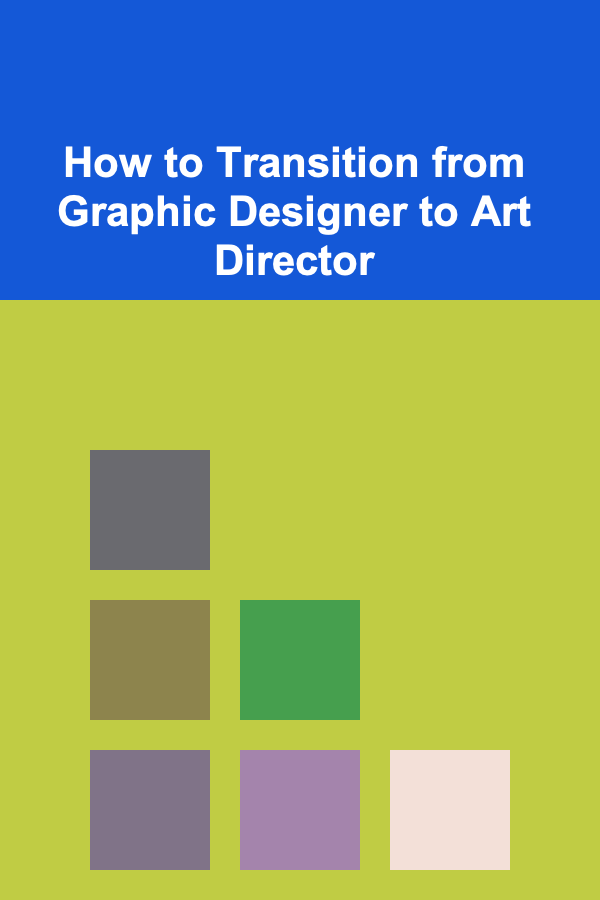
How to Transition from Graphic Designer to Art Director
ebook include PDF & Audio bundle (Micro Guide)
$12.99$9.99
Limited Time Offer! Order within the next:

Transitioning from a graphic designer to an art director is an exciting career move that offers new challenges, greater responsibility, and a broader creative scope. However, making this shift requires more than just mastering design software or techniques; it involves expanding your creative leadership skills, gaining a deeper understanding of the design process, and enhancing your ability to manage people and projects.
This article explores the steps you can take to successfully transition from a graphic designer to an art director, the skills and mindset changes required, and how to prepare yourself for this next stage in your creative career.
Understanding the Role of an Art Director
Before diving into the transition, it's essential to understand what an art director does and how their responsibilities differ from those of a graphic designer. The primary role of an art director is to oversee the visual aspects of a project, ensuring that the design aligns with the creative vision and meets the client's or brand's objectives. They manage teams of designers, photographers, illustrators, and other creative professionals to bring concepts to life.
While graphic designers focus primarily on executing designs---such as creating logos, layouts, and visual identities---art directors take on a leadership role that involves strategic thinking, client interaction, and managing the entire creative process. Art directors must think about the big picture, from conceptualizing designs to ensuring that the final product communicates effectively.
Some key responsibilities of an art director include:
- Developing creative concepts and visual directions for projects.
- Leading and managing a team of designers and other creative professionals.
- Collaborating with clients to understand their needs and deliver solutions that meet their objectives.
- Ensuring design consistency across all brand materials.
- Overseeing the production process, from concept to final execution.
Building Strong Leadership Skills
One of the most significant differences between being a graphic designer and an art director is the level of leadership required. As a graphic designer, you are primarily responsible for your own work, but as an art director, you will need to manage a team of creatives, ensure they meet deadlines, and guide them toward achieving the desired results.
Key Leadership Skills to Develop:
- Communication: Art directors must effectively communicate their vision to the team and clients. This means articulating design concepts, giving constructive feedback, and ensuring everyone is on the same page.
- Delegation: While you might be used to handling all aspects of a project as a graphic designer, as an art director, you will need to delegate tasks to team members. Trusting your team and empowering them to contribute their skills is crucial.
- Problem-Solving: Art directors often face challenges related to project constraints, creative differences, or changes in direction. Strong problem-solving skills are essential for resolving issues and maintaining progress on the project.
- Motivating the Team: An art director should inspire and motivate the team to push creative boundaries while maintaining a positive and productive work environment.
Transition Tip:
Consider taking on leadership roles within your current projects, such as mentoring junior designers, leading brainstorming sessions, or taking the initiative to organize team efforts. This will help you build the leadership skills necessary for your new role.
Expanding Your Creative Vision
As a graphic designer, you are accustomed to focusing on the details of individual design elements. However, as an art director, your role requires you to think in terms of the bigger picture. You must have the ability to envision how all the visual components of a project come together to form a cohesive and compelling story.
Enhancing Your Creative Vision:
- Understand Branding: Art directors need a deep understanding of branding principles. Your job is not just to create beautiful designs, but to ensure that every design decision aligns with the brand's identity and objectives.
- Learn About Strategy: Art directors must think strategically, considering the client's goals, the target audience, and the best way to communicate a message visually. This means understanding the market, trends, and user behaviors.
- Keep Up with Trends: While it's important to create timeless designs, art directors must also be aware of current design trends and how to incorporate them into projects while staying true to the brand's voice.
Transition Tip:
Start working on projects that require a more strategic approach, such as branding or advertising campaigns. Practice developing design concepts that align with a larger vision, not just the individual elements of the design.
Mastering Project Management
Project management is a crucial aspect of being an art director. You will be responsible for coordinating the work of multiple designers and other creative professionals, ensuring that everything is delivered on time, within budget, and to the highest standard.
Project Management Skills to Focus On:
- Time Management: Art directors need to manage their time efficiently, balancing multiple projects, deadlines, and client meetings. A well-organized schedule is key to keeping everything on track.
- Client Management: Art directors often interact directly with clients, understanding their needs, providing updates, and managing expectations. Strong client communication is vital for the success of a project.
- Budgeting and Resource Allocation: Art directors are often responsible for managing the budget for a project. This includes allocating resources effectively, ensuring the team has the tools they need, and keeping costs within the allocated budget.
Transition Tip:
Take the opportunity to manage small-scale projects on your own, such as coordinating a group of designers or overseeing a campaign. Learning to juggle multiple tasks and communicate effectively with clients will help you prepare for the managerial aspect of the art director role.
Improving Your Technical Skills
While the focus for art directors is more on leadership and creative direction, having strong technical skills is still important. You need to be proficient in design software like Adobe Creative Suite (Photoshop, Illustrator, InDesign), as well as other tools relevant to your industry (e.g., Sketch, Figma, InVision for digital projects).
However, being an art director isn't just about technical proficiency. You also need to understand production processes, whether for print, digital media, or video. This includes knowing how to optimize designs for different platforms, understanding file formats, and working with various types of media.
Technical Skills to Develop:
- Cross-Platform Design: Understand how to design for a variety of platforms, from print to web to social media. Each platform has unique requirements, and as an art director, you will need to ensure designs work seamlessly across all channels.
- Prototyping and Interaction Design: Familiarity with prototyping tools and interaction design principles is particularly important for art directors working in the digital space.
- Photography and Video: If your work involves photography or video, having a basic understanding of these mediums and how they integrate into the overall design process will be beneficial.
Transition Tip:
Start working on projects that require cross-platform design or that incorporate multimedia elements. This will help you develop the technical skills needed to manage a broader range of projects as an art director.
Building a Strong Portfolio
To make the leap from graphic designer to art director, you'll need a portfolio that reflects your ability to lead and create cohesive, high-level designs. Your portfolio should showcase your best design work, but it should also highlight your ability to manage and direct projects.
What to Include in Your Portfolio:
- Conceptual Work: Include work that demonstrates your ability to develop and execute a creative vision from start to finish.
- Team Projects: Showcase any projects where you led or collaborated with a team. Highlight how you guided the design process and worked with other creatives to achieve the desired outcome.
- Client Work: If you've had experience working directly with clients, include those projects in your portfolio to demonstrate your client management skills.
- Process Work: Show the process behind your work, from brainstorming and sketching to final execution. This will give potential employers or clients insight into how you approach design problems.
Transition Tip:
If possible, take on freelance or side projects where you can work as a project lead or art director. This will give you real-world experience and provide material for your portfolio.
Networking and Building Relationships
Building a strong network is essential for career growth. As an art director, you will need to collaborate with various stakeholders, including clients, designers, copywriters, photographers, and other creatives.
Tips for Networking:
- Attend Design Conferences and Events: Participate in industry events, workshops, and conferences where you can meet other creative professionals and stay up-to-date on trends.
- Join Design Communities: Online communities and social media platforms like LinkedIn, Dribbble, and Behance are great places to connect with other designers and art directors.
- Seek Mentorship: Finding a mentor who has experience as an art director can be incredibly valuable. They can provide guidance, advice, and support as you navigate your transition.
Transition Tip:
Engage with other creative professionals and seek out opportunities to collaborate or learn from those already in the art director role. Building relationships with other professionals will not only open up career opportunities but also help you develop your leadership skills.
Seeking Feedback and Continuous Improvement
Transitioning to a new role requires ongoing self-assessment and feedback from others. As you step into the role of an art director, seek feedback from your peers, mentors, and clients to continually improve your leadership and design skills.
Feedback Strategies:
- Self-Reflection: Regularly assess your work and leadership style. What's working well? Where can you improve?
- Peer Feedback: Ask your team for constructive feedback on your leadership and creative direction.
- Client Feedback: Client satisfaction is a critical measure of success. Regularly check in with clients to ensure their needs are being met and gather feedback on your work.
Transition Tip:
Make feedback a regular part of your workflow. Embrace both positive and negative feedback as an opportunity to grow and refine your skills.
Conclusion
The transition from graphic designer to art director is a significant step in your creative career. It requires a shift in mindset---from focusing on design execution to taking a broader, more strategic view of creative projects. By developing strong leadership skills, expanding your creative vision, mastering project management, and enhancing your technical expertise, you can successfully make this transition.
With dedication, ongoing learning, and a willingness to take on new challenges, you'll be well on your way to becoming a successful art director and advancing in your creative career.
Reading More From Our Other Websites
- [Home Budget Decorating 101] How to Sew Your Own Stylish Window Coverings: DIY Curtains and Window Treatments for Every Room
- [Organization Tip 101] How to Store Seasonal Decor Without Taking Up Too Much Space
- [Home Space Saving 101] How to Select the Perfect Space-Saving Dining Tables: Size, Shape, and Style for Every Home
- [Screen Printing Tip 101] Best Techniques for Achieving Transparent Overlays in Multi‑Color Screen Printing Designs
- [Home Pet Care 101] How to Choose the Right Pet-Proof Furniture for Your Home
- [Tiny Home Living Tip 101] How to Set Up a Tiny Home Office That Boosts Productivity
- [Home Cleaning 101] How to Disinfect and Clean Your Cutting Boards
- [Tie-Dyeing Tip 101] DIY Tie-Dye Trends: Turning Your Wardrobe into a Runway-Ready Statement
- [Organization Tip 101] Why Organizing Your Travel Gear Saves Time
- [Home Security 101] How to Perform Regular Home Security Audits to Keep Your Family Safe

Financial Statement Analysis Techniques: Uncovering the Secrets of Corporate Health
Read More
How to Create Themed Displays for Your Hobby Items
Read More
How to Incorporate Breaks into Your Remote Learning Schedule
Read More
How to Understand Your Tax Situation and Plan Accordingly
Read More
How to Study Marine Food Webs and Trophic Levels
Read More
How to Groom Your Cat Without a Fuss
Read MoreOther Products

Financial Statement Analysis Techniques: Uncovering the Secrets of Corporate Health
Read More
How to Create Themed Displays for Your Hobby Items
Read More
How to Incorporate Breaks into Your Remote Learning Schedule
Read More
How to Understand Your Tax Situation and Plan Accordingly
Read More
How to Study Marine Food Webs and Trophic Levels
Read More